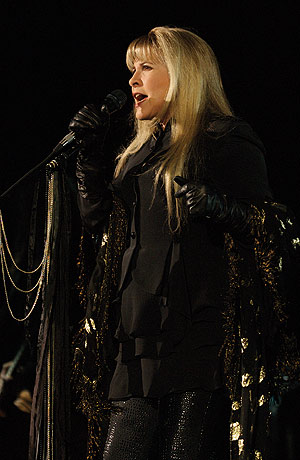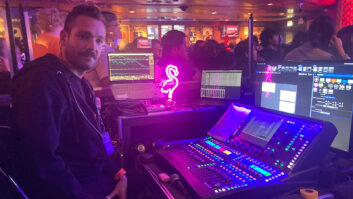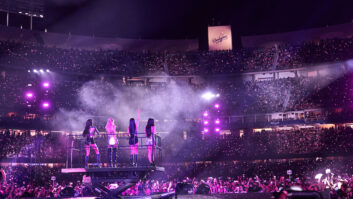
All Photos: John Johnston
It is, as front-of-house engineer Dave Morgan says, “One of the most unique instruments: Everybody knows it’s Stevie Nicks singing as soon as you hear the first note of a song.” The longtime Fleetwood Mac vocalist walks onstage at Denver’s Red Rocks Amphitheater, does a few twirls and launches into “Stand Back.” She’s currently on tour with Chris Isaak, hitting large venues across the country to promote her new anthology, Crystal Visions. The set includes some of her best solo pieces, classic Fleetwood Mac songs and a few surprises, including a roaring cover of Led Zeppelin’s “Rock and Roll.”
Nicks is supported onstage by guitarists Waddy Wachtel and Carlos Rios, keyboardists Cornell Thigpen and Ricky Petersen, drummer Jimmy Paxson, percussionist Lenny Castro, and backing vocalists Lori Nicks, Jana Anderson and Sharon Celani. These musicians continually provide a tight foundation for Nicks’ trademark style. The job of translating that sound falls on Morgan and monitor engineer Brian Hendry.
Morgan, who grew up in Boston playing hockey and now lives in California, was watching the first game of the Stanley Cup finals when Mix visited the tour. “I’m not too interested in talking about engineering with the Stanley Cup finals on, so you’ll have to steer me,” he says with a laugh. Morgan was in a chipper mood throughout the evening, as the Anaheim Ducks won the first game over the Ottawa Senators.
Both Morgan and Hendry are tour veterans, but this is their first time out with Nicks. Hendry has crisscrossed the world with such acts as Deep Purple, the Rolling Stones and Led Zeppelin in Europe. He came to the States in ’76 with Thin Lizzy, then jumped into an Aerosmith tour and later began a 14-year run with Tom Petty & The Heartbreakers. During last year’s Petty tour, Nicks was a guest vocalist for 27 shows, and she liked Hendry’s approach to mixing. Morgan first did a one-off with Nicks in December 2005, and has been mixing her shows since February.
DIGITAL IS KEY

Front-of-house engineer Dave Morgan: “I would much rather look at a venue, look at the variables myself, make the decisions and array the P.A.”
Both engineers are using a Digidesign D-Show VENUE. “I started using the Digi in February with James Taylor,” says Morgan. “With his One Man Band tour, I’m was using the smaller version, the Profile, and I was really thrilled with the available features and the audio quality. The results obtained with the Digidesign desk led me to specify it for this tour, and I’ve had nothing but wonderful success translating this show from the stage to the audience.
“Using the TDM plug-ins is the entire game,” Morgan continues. “You can configure your board to be whatever you want it to be. If you want it to have a classic tube sound, you can use a lot of classic tube plug-ins. If you want it to have a fat, Class-A sound, you can do that, too. You go through the libraries of plug-ins on the [Digidesign] Website and then ask your sound company to include those on the menu on the console. You can just pop them in during rehearsal and see if they work. If they don’t, you just go to the library and start all over again. It really gives you a whole new level of creativity.”
Adds Hendry, “The studio plug-ins I’m using are awesome. Having the Pro Tools rig with me, I can use that for playback and you can set all your dynamics and mixes.” The plug-ins loaded up on his desk include a Phoenix Crane Song Luster on Nicks, a Digidesign proprietary Smack! digital tube compressor and a Reverb One. “There’s a lot of ‘verb for her; it sounds really big,” he explains.
Morgan uses a few more tricks: “I use a pair of LA-2As on piano and Fairchild 670 stereo tube compressors on all the synthesizer inputs to warm them up. I use 1176s and three different TC Electronic 6000 reverbs: One’s on the drums, one’s on the acoustic guitars and the other is on the keyboards. I use both ReVibe and Reverb One. With the proper quantity of processing power, you have an almost infinite amount of choice, and it’s not limited to what your sound company has on the shelves at the time.”
Morgan is flying a Clair Bros. i3 three-way line array for Nicks, which he tunes by ear for the venue. Because the cabinets are relatively light — about 100 pounds each — the sound crew has no trouble adjusting angles by hand. At Red Rocks, with its steep seating, Morgan and Clair crew chief Andy Sottile make an initial determination on angles when they get to the venue, fly one side, observe the array, make a few adjustments to the other side and then reincorporate those changes into the first side. “It’s not like you have to sit there with a spreadsheet and accept somebody else’s word about what coverage is going to be,” Morgan says. “I would much rather look at a venue, look at the variables myself, make the decisions and array the P.A.”
INSIDE STAGE-LEFT
Most of the band uses in-ear monitors, though Wachtel and Castro use Clair CBA 12AM wedges. “We’ve got Plexiglas around all the percussion and drums,” says Hendry. “To make it work for in-ears, I’ve got ambient mics to get the audience and the P.A. to make it sound natural and not closed in.”

Monitor engineer Brian Hendry: “When you work with music that you care about and like, you put more into it.”
In terms of a mixing style, Hendry says that he follows the album as a guide. “It’s her on top, vocals layered down, everything in there, and when there’s a solo I bring it up, whether it’s keys or guitar, on top of that and then bring it back down,” Hendry explains. The backing vocalists get a similar mix. “One of them is usually on top of the other and layered down with the other two and Stevie, so they’re hearing their part marginally ahead of the other females.” Wachtel and Rios both get Nicks and a lot of percussion, while Ortiz, Peterson and Castro get a solid rhythm mix.
Hendry and Morgan both feel lucky to be part of this tour. Says Hendry, “When you work with music that you care about and like, you put more into it. When you love the music, you can get it so that [an audience member] can shut his eyes and sing like he’s in the shower. When you know it’s all going on and you’re in the pocket, you find yourself appreciating it more.”
Adds Morgan, “This is a labor of love for me. Many old friends are in this band, and I’m having the time of my life. Everybody brings their wonderful flavor. What these guys do is make me look really good. I would be hard-pressed to ask for a much better job.”
ALL MIKED UP
Stevie Nicks likes to sing into a Sennheiser 935 dynamic microphone, as do all the backing vocalists. Says Morgan, “With most everyone on in-ears, the amount of off-axis stuff that comes in with a dynamic is significantly less than with a condenser, and it tends to give you better separation in the ear mixes and you also have a lot less random high-end leakage.”
Rios uses a Line 6, so he goes direct to the P.A. Wachtel uses a Mesa cabinet and a Marshall cabinet; Morgan puts a Shure KSM 27 on each cabinet. On Petersen’s B3, Morgan puts two Audio-Technica AT4047s on the high rotor and an MD421 on the bottom.
The drum setup is fairly standard: Shure Beta 91 and Beta 52 in the kick, Shure SM57 on the top of the snare, a Beyer M201 underneath snare, a Neumann KM184 on the hi-hat, Shure SM98s on the toms, another KM184 underneath the ride cymbal and Shure KSM44s on overheads.





